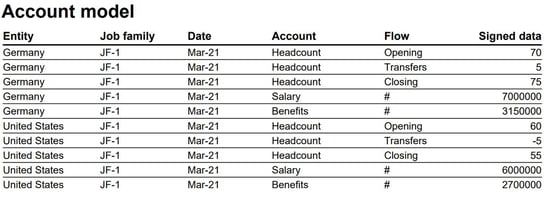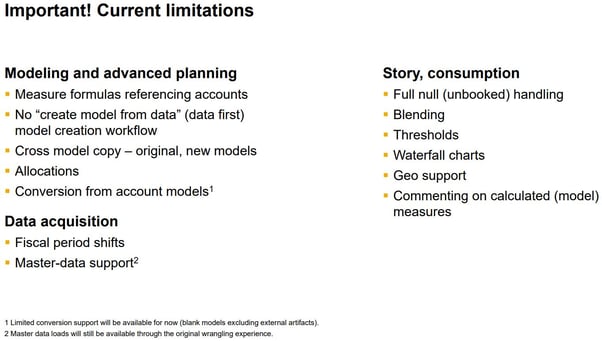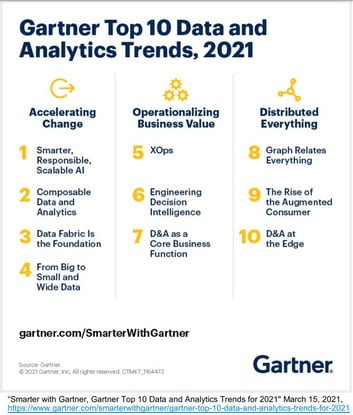The SAP Analytics Cloud, or SAC for short, is SAP's current flagship dashboarding tool. At this stage, however, the SAC still displays some weaknesses, which are particularly apparent when drawing comparisons to other tools. The SAC is lacking flexibility in the implementation of dashboard features as, for example, still not all CSS and scripting functionalities are available.
We currently see the strengths of the SAC more in the planning area. However, SAP is always working on improvements for its tools, as TechEd 2021 showed.
This year's TechEd took place from November 16. until November 18. There were many exciting presentations on a wide variety of SAP topics. In this blog post we want to briefly introduce what we consider to be the most exciting topics in the field of SAC and explain the importance of these topics from our point of view.
These are the three topics we selected, including a brief introduction and assessment:
- The New Model
- Planning in the Analytics Designer - now and in the future
- The future topics in the field of company data and analyzes - the future of SAP
1. The New Model
Until recently, an account model was required in a planning application in order to be able to use all the features and functions of the SAC in the planning area. However, if you build a report on an account model, you will often run into problems. For example, some charts cannot be displayed with an account model. The new model, released with the Q2 / 2021 update, combines the key figure model with the account model, although there is currently a clear focus on planning applications.
Two screenshots from the TechEd Talk show exactly how the new model looks:


In this example from SAP, the account model becomes a hybrid in which the “Flow” dimension is broken down into several key figures, while the “Account” dimension remains as a dimension. The result is neither a pure key figure model nor an account model. However, SAP is now adding various additional functions, such as a currency variable. This variable enables an ad hoc changeover of the currency in stories and applications.
It should be noted here that the new model currently does not allow a live data connection, but is only available with data import.
But why did SAP decide to develop this model? What are the specific strengths of the model?
A major advantage of the New Model is that central key figures can now be saved and be made available in all models, which is why we can speak of a kind of “template for key figures”. Furthermore, formulas for key figures and dimensions are possible in the model, which opens up undreamt-of possibilities, especially in planning. But also “little things” like the source and target assignment via drag & drop make the developers' work much easier. Unfortunately, the model is still under development and is currently primarily geared towards planning, which means that there are many limitations, especially in dashboarding, as the following table illustrates:

The restrictions listed in the diagram are taken from a presentation by TechEd. A detailed description of the limitations listed here can be found in the presentation. Among other things, the New Model does not have the option of automatically generating a model when importing data. Instead, an empty model must first be created, before data can be imported from an Excel file. As a result, the model has to be created entirely by hand, whereas the old model even automatically determined and adopted the data types of all data through the import. Due to those limitations, we are currently still recommending the old model to our customers.
What effects does the “New Model” have on the SAC?
With the New Model it will be possible to use the same model for dashboarding and planning applications. However, some adjustments are still required on the part of SAP in order to ensure problem-free use. As soon as this has been done and all features are ready for use, it will significantly simplify the modeling for dashboarding and planning applications. Furthermore, SAP promises better performance than with the standard model, which once again suggests that the New Model could be a complete success for SAP.
Dashboarding with SAP Analytics Cloud -
Download the whitepaper here!
2. Planning in the Analytics Designer - now and in the future
The Analytics Designer is an IT tool for creating enterprise dashboards or planning applications. Initially, SAC only had the option of creating self-service stories, which meant that many Lumira Designer reports could not be replicated in SAC due to the technical limitations. Since the introduction of the Analytics Designer, however, more and more gaps in the Lumira Designer have been closed. The Analytics Designer enables customers to create complex web applications that can be tailored to individual and diverse requirements with the help of scripting. Users can use visual widgets to create dashboards as well as planning and predictive applications.
In the TechEd presentation, typical use cases, advantages as well as features and functions of the Analytics Designer were presented. We will look at these in the following and evaluate them in summary in order to be able to assess the future of the Analytics Designer.
The use cases
The Analytics Designer can be used to develop dashboards that cannot be created in normal stories because the lack of scripting functions restricts the implementation of your own logic.
Planning and predictive applications can also be developed. With planning applications in particular, SAP particularly emphasizes calendar integration, as this can be used very practically for starting planning processes or other data actions. The interactive dashboards, such as predictive "what-if" applications or "self-guided" dashboards that are made possible with the Analytics Designer, represent immense added value for the SAC.
But what are the advantages compared to the stories also contained in the SAC?
- (Limited) CSS integration
- Extended responsive design
- Programmatic access to OData
- Flexible navigation
- Hyperlink support for image and shape widgets
- Custom widget SDK
- Scripting
These are just a few of the many benefits mentioned in the TechEd presentation.
Now we come to the presented features and functions of the Analytics Designer. Reuse in planning applications is one of the many functions that are in the foreground. All planning applications that SAC has already offered can be brought together in the Analytics Designer. Planning data models, assignments, triggers for data actions or value driver trees - all components can be reused and brought together in a single dashboard.
At the time of the release, the Analytics Designer was a very good addition to the SAC. Unfortunately, like the entire SAC, the Analytics Designer is still missing some functions, which is why the Designer sometimes performs poorly compared to other competitor tools. Some features, such as an “undo” button or data binding for custom widgets, have long been expected by developers. However, SAP continued to postpone the release of these features. The year 2021 showed that SAP is concentrating more and more on the strong planning component of the Analytics Designer. A look at the roadmap shows that the Analytics Designer 2022 will get many long-awaited features and enhancements not only in the planning area but also in the dashboarding area. Thanks to the Analytics Designer, the SAC is already a strong planning tool. However, even though the tool offers many possibilities, it does not yet come close to machine learning.
3. The future topics in the field of business data and analyses - the future of SAP
SAP is always trying to be orientated towards current trends. When analyzing trends and also when ranking, SAP relies on Gartner as one of the strongest providers of market research results and analyses of developments in IT. The top 10 data and analytics trends from Gartner are as follows:

The TechEd-Talk [INT203] dealt intensively with all of these trends. It shows the implementation plans and ideas of SAP for every trend and thus gives a good outlook on future developments at SAP.
The top trend Gartner sees relates to the use of artificial intelligence (AI). This is exactly where SAP wants to step up by developing a solution that leaves no questions unanswered. The vision goes towards an AI that can provide very good, intelligent answers despite little information. To find out what the SAC already has to offer in terms of AI and ML features, we recommend our blog: "Can SAP Analytics Cloud perform machine learning?".
SAP shows that it sees the trends and developments in the market and, as we know from SAP, wants to continue to orient itself towards the market in the future, in order to be able to catch up with other tools such as Power BI and Tableau.
In our opinion, the TechEd presentations that SAP has held this year were all very informative and interesting. We can therefore recommend the TechEd reviews to deepen individual topics.
The future of the SAC is quite difficult to predict at the moment. The fact that SAP presented a new data model this year, which has been developed largely unnoticed over a long period of time, gives reason to hope that other major developments are in the works at SAP. As TechEd has shown, SAP continues to focus strongly on the market for planned developments. Long-awaited extensions such as the lack of data binding for custom widgets are already on the roadmap for next year. At the moment, however, we have to realize that the SAC has noticeable weaknesses and is therefore still far removed from tools such as Tableau and Power BI. At this point, we rate SAC to be a solid front-end tool with a strong planning component. It offers particular advantages for customers who already rely largely on SAP.
Do you have any questions on this or other topics? Are you trying to build up the necessary know-how in your department or do you need support with a specific question? We'll help you. Request a non-binding consultation offer today.
SAP Analytics Cloud, Dashboarding


























